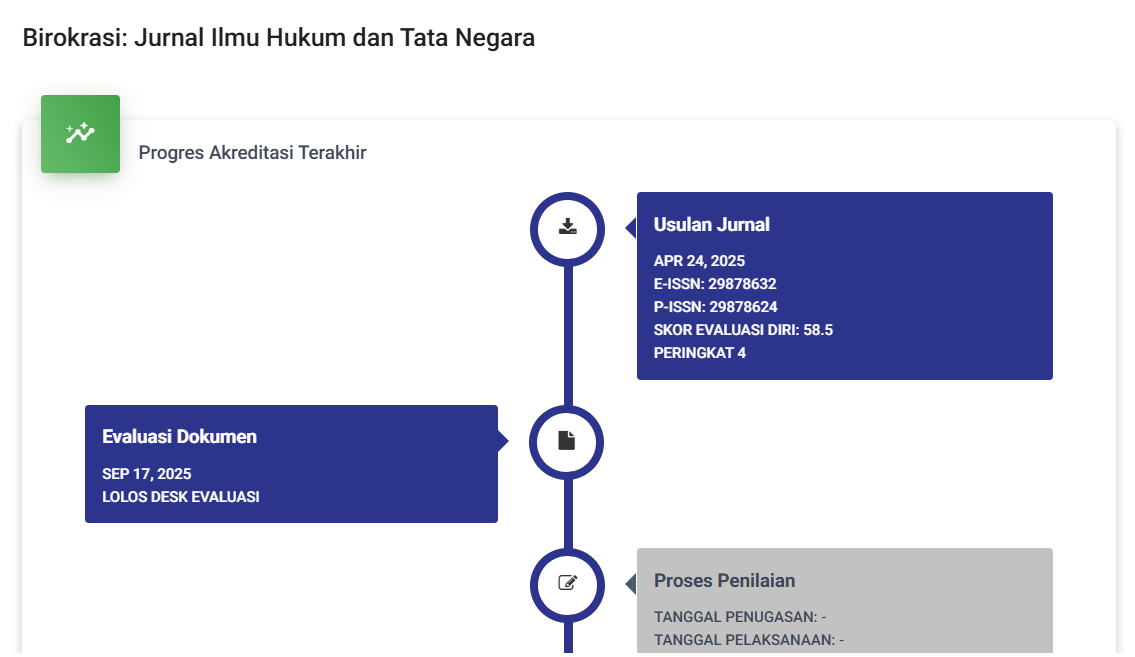Implementasi Kebijakan Pengentasan Kemiskinan Oleh Dinas Sosial Kabupaten Lingga Dalam Perspektif Sustainable Development Goals
DOI:
https://doi.org/10.55606/birokrasi.v1i2.448Keywords:
Implementation, Powerty, Sustainable Development Goals (SDG’s)Abstract
The Sustainable Development Goals (SDG's) have 17 goals from 2015 to 2030. The Sustainable Development Goals (SDG's) are in line with the vision and mission of President Joko Widodo and Vice President Ma'aruf Amin in the 2020-2024 National Medium Term Development Plan. Then it was aligned into the Lingga Regency Medium Term Development Plan 2021-2026. The background of this research is to measure how far the Lingga District Social Service has implemented poverty alleviation in implementing the Sustainable Development Goals (SDG's) Program to reduce poverty in Lingga District. The method used in this research is using a qualitative descriptive approach with primary and secondary data sources and using data collection techniques by observation, interviews, and documentation. The theory used in this study is the Van Meter Van Horn Theory with six indicators, namely policy standards and targets, resources, characteristics of implementing agents, attitudes of implementers, inter-organizational communication, social, economic, and political environment. The results of the research are based on the first indicator, namely the standards and policy targets have a direct impact on coastal communities in Lingga Regency so that they are said to be poor. The second indicator is resources, the existing resources are in accordance with the standards set even though there are some human resources who still commit fraud. Indicator. The third is that the characteristics of implementing organizations have implemented existing policies in a firm and disciplined manner towards beneficiaries. The fourth indicator is the attitude of the implementers to accept the policy, it's just that there is a lack of response from Social Service employees and supervision is carried out. The fifth indicator is that communication between organizations has been established, it's just that the executors rarely come into the field for various reasons. Thus causing fraud. The sixth indicator, namely the social, economic and political environment, has been implemented with the government's efforts to improve the welfare of the community. The conclusion of this study is that the Lingga District Social Service has implemented a poverty alleviation program based on the Sustainable Development Goals Program in Lingga District.
References
Abdussamad, Z. (2021). Metode Penelitian Kualitatif (P. Rapanna (ed.); 1 ed.). Syakir Media Press.
Agustino, L. (2016). Dasar-dasar Kebijakan Publik (keenam). alfabeta.
Ahmad, Mahsyar, A., & Parawangi, A. (2021). Implementasi Program Pemberdayaan Masyarakat Desa (P2MD) Di Dinas Pemberdayaan Masyarakat Desa Kabupaten Kepulauan Selayar. … Jurnal Administrasi Publik, 7(1).
AULIA, S. H. (2020). Peran United Nations Development Programme (Undp) Dalam Mewujudkan Sustainable Development Goals (Sdgs) Bidang Pengentasan Kemiskinan Di Indonesia (2016 – 2019). fisip.
BPS. (2021). Berita Resmi Statistik. Website BPS.
Handrian, E., & Andry, H. (2020). Sustainable Development Goals: Tinjauan Percepatan Pencapaian di Provinsi Riau. PUBLIKA : Jurnal Ilmu Administrasi Publik, 6(1).
Rachmatullah, R., Endaryanto, T., & Affandi, M. I. (2021). Pengarusutamaan Sustainable Development Goals (SDGS) Program Pengentasan Kemiskinan di Kota Pagar Alam. TATALOKA, 23(2). https://doi.org/10.14710/tataloka.23.2.239-251
Safitri, A. O., Yunianti, V. D., & Rostika, D. (2022). Upaya Peningkatan Pendidikan Berkualitas di Indonesia: Analisis Pencapaian Sustainable Development Goals (SDGs). BASICEDU, 6(4), 7096–7106.
Sugiyono. (2014). Metode penelitian kuantitatif kualitatif dan R&D (keduapuluh). alfabeta.








